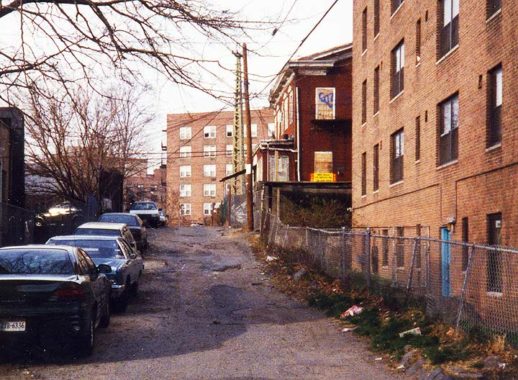
March 2019 marks Forgotten New York’s 20th anniversary. To celebrate the occasion, I’ve re-scanned about 150 key images from the early days of FNY from 35MM prints. In the early days, when people including me were accessing FNY with dial-up modems, I had to save photos really small — in some cases, just 4″ across. I couldn’t find all those early photos — I think I foolishly discarded some along the way — but all month, and into April, I’ll be picking out some and showing the newly scanned versions.
What does a rubble-strewn alleyway on Dongan Avenue just off Broadway in Elmhurst have to do with a British department-store magnate whose flagship store recently closed in midtown Manhattan? Plenty, as a matter of fact.
Samuel Lord (1803-1889) was a British foundry worker from Yorkshire who came to the USA with dreams of entrepreneurship, opening a drapery-dry goods shop on Catherine Street in what is now the Lower East Side in 1824, and after struggling for over a decade, he sent for his wife and children to join him in the USA. At about the same time his brother-in-law, George Washington Taylor, joined him as a partner and investor.
Lord and Taylor opened a larger store near the docks at Grand and Chrystie Streets in 1854, at a time when Grand was among the city’s busiest shopping streets — it was close to the east side docks along South Street, making importing goods a simple matter. The business became wildly successful, both men were millionaires by the early 1860s, and were then able to retire and return to England. The store moved to 20th Street and Broadway in 1902 and then to 5th Avenue and 38th Street in 1914, where it had continued an over 150-year run of success before closing at the end of 2018.
In 1840, while he was still struggling on the Lower East Side, though, Samuel Lord bought property in Newtown — today’s Elmhurst.
Lord purchased a house at today’s Broadway and Elmhurst Avenue in 1840, and opened a country store across the road. He was committed to Newtown — he commuted by ferry to the Lower East Side each day, and evidently liked what was then a small town, acquiring over 100 acres centered around today’s Broadway where it crosses the Port Washington Branch of the Long Island Rail Road.
In 1856, Lord built four 2 and a half story mansions for his four daughters along a semicircular path that he named Clermont (later Claremont) Terrace — it was on a short rise — on Broadway just south of the new LIRR branch, which was built shortly after the mansions were. Up to about 2006, the last remaining of those four buildings was still standing, shown at the right rear of the above photo. Subsequently it was mostly razed and a new development began to get underway — but apparently the developer ran out of money, and the abandoned hulk has stood there ever since.
One small remnant of the last Lord mansion is still there — the entrance steps, which were never removed.
Check out the ForgottenBook, take a look at the gift shop, and as always, “comment…as you see fit.”
3/22/19
